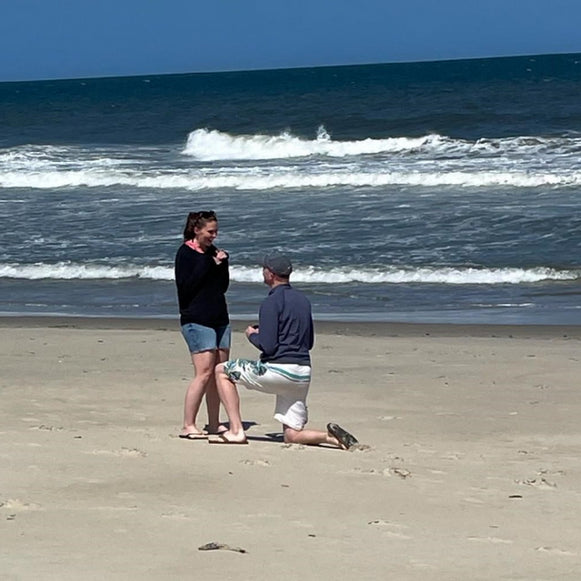Buying a diamond can seem like a daunting task if you don’t know what to look for. This is especially true when you want to buy a loose stone or create a custom piece. At the end of the day, there are two aspects of cut to know about: cut style and diamond shape. Let’s look at each.
Cut Style
Because diamond shapes can come in different cut styles, let’s talk about this first. In a nutshell, there are three basic cuts: brilliant, step, and crushed ice. Each of these has different patterns.
Brilliant cuts
With a brilliant cut, the facets are shaped like triangles, diamonds, and arrows. In addition, at least some of the surface is curved. Finally, the top of the diamond is called the “table,” and it will have many sides. The center of the gem called the “girdle,” can be cut with curved facets, polished, or left frosted (cloudy). What this means in practice is that a brilliant cut is designed to let as much light “bounce” back off the facets and into the eye of an observer. Modern brilliant cuts are said to have “sparkle,” while older ones have “fire.” Either way, the standard brilliant cut features 58 facets.
Step cuts
Step cuts are a little bit more “boxy.” This is because their facets are typically parallel to the facet on the opposite face. Think of it this way: when you look at a box, it holds together best when the corners are squared off. Most of the facets will have four corners, as well. Most step cuts are either basically square or rectangular, with or without the corners cut off. Overall, these cuts create a “hall of mirrors” effect. Step cut diamonds don’t have much “sparkle.” Instead, they showcase light from deep within the stone.
Crushed ice
One of the cut types that people have talked about a lot lately is the “crushed ice” trend. With a crushed ice diamond, a lot of smaller facets are placed on the lower half of the diamond. This reflects the light in many different directions, which is in contrast with the goal of step or brilliant cuts. Both of these other styles direct light towards the top of the diamond. As a result, crushed ice diamonds often have a more “frosted” look: just like the cut’s namesake.
Diamond Shapes
Now that you understand the differences between the different cut types, let’s talk about shape. Here, shape is the silhouette you’ll see from the top of the diamond.
Round

Round diamonds are just what you’d expect: modern rounds are the same diameter at the top from every direction. They are classic due to their long history. Over a century ago, round diamonds with a “brilliant” facet type were called “old European” diamonds. What’s the difference? Old European cuts are the immediate precursors to the modern round brilliant. They had the same 58 facets but were cut deeper. This meant that for the carat weight, they had less of a surface area than modern round diamonds. As a result, these older diamonds have a glow from within, a phenomenon called “fire.” Nowadays, the diamond is cut shallower, which lets more light escape . Experts will tell you that the difference came when modern gem cutting technology was developed in the 1930’s.
Pear

Pear shaped diamonds are a fashionable, yet classic, choice. They are shaped like a pear or teardrop, and cut with brilliant-style facets. Traditionally, they have been popular for earrings with the point closer to the ear. However, in recent years people have started using them for engagement rings or pendants. Some are longer for the width, while others are shorter and wider.
Oval

Another variety of brilliant cut, oval diamonds are very popular for engagement rings. Shaped as you’d expect, these have the advantage of helping to elongate the wearer’s fingers. In addition, a lot of people are choosing oval diamond rings with a “halo” setting. This means that a ring of small diamonds is set along the edges of the stone. Another popular use for oval diamonds is to have the stone set from east to west. Fashion rings frequently use oval stones, as well.
Marquee

Marquee (or marquise) diamonds are a brilliant cut shape with two sharp points and a wide middle. Think of them as a surfboard with sharp points at each end, or an oval that comes to a sharp point. Marque diamonds can be used for many different types of jewelry, including engagement rings and earrings.
Princess
Emerald

Asscher
Cushion

Cushion cuts are essentially a brilliant cut diamond in a rounded off square silhouette. In addition, cushion cut diamonds have a deep bottom, reminiscent of a pillow hence the name. Originally known as “old mine” diamonds, they evolved as diamond cutting got more sophisticated. Nowadays, there are several versions of the cushion shape. This includes “crushed ice” cushions, which have a high level of brilliance that some people love. Overall, cushions are one of the most popular engagement ring choices today.
Radiant
Finally, let’s look at the radiant shape. These have 70 facets, and are shaped the same as an emerald diamond. In fact, their top facets are step-style. However, on the pavilion (bottom), they have brilliant facets. This makes for a unique stone with both fire and depth. The most expensive radiant diamonds are elongated rectangles. However, more “square” Radiants are often confused with cushion cuts.
For a more thorough discussion of the evolution of round brilliant diamonds, check out this article on the GIA website https://www.gia.edu/gia-news-research-round-brilliant-cut-diamond-pay








